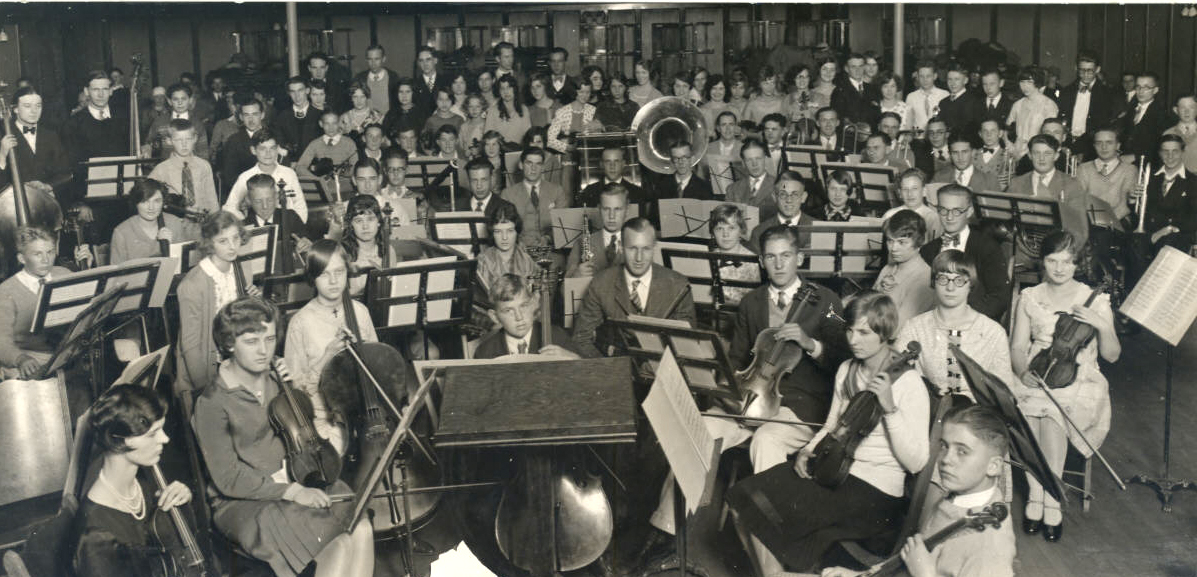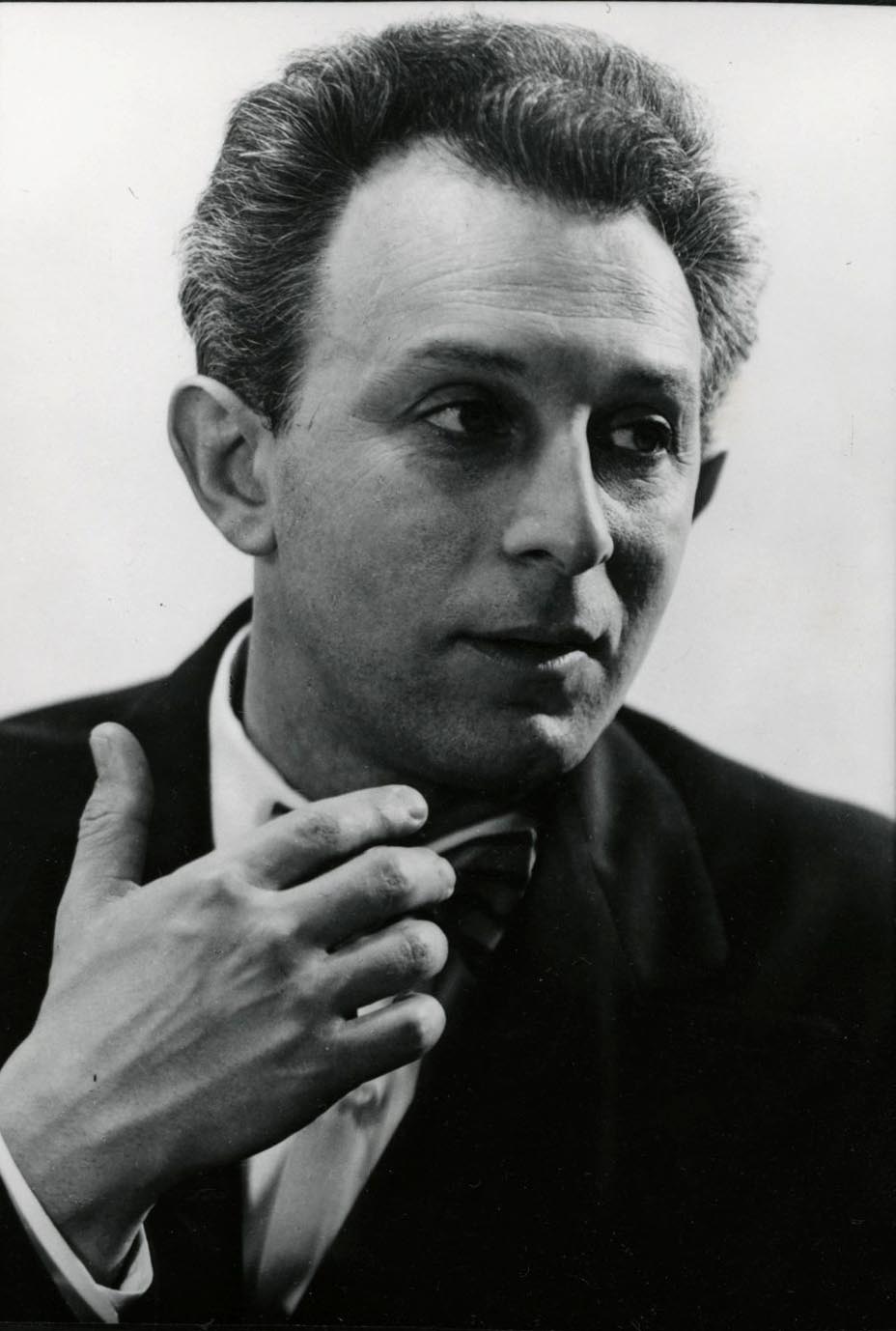Established in 1924, the Portland Youth Philharmonic is the oldest youth orchestra in the United States. Its origins date to 1919, when violin teacher Mary V. Dodge—former leader of the Harney County Sagebrush Symphony—became the music director of Portland's Irvington School. In addition to the school's orchestra, she formed an advanced orchestra that rehearsed in her house.
In 1923, Dodge engaged Jacques Gershkovitch, a Russian émigré and guest conductor of the Portland (now Oregon) Symphony, to take over the advanced orchestra, which became the core of the new Portland Junior Symphony (PJS) the following year. The PJS gave its first performance on Valentine's Day in 1925 at the Lincoln High School Auditorium (now Portland State University's Lincoln Performance Hall).
Like Dodge, Gershkovitch was known for his discipline and high performance standards, and the orchestra grew in size and stature during his thirty-year tenure. In the 1930s, PJS concerts were broadcast internationally on the CBS Radio Network. With membership burgeoning, the organization added the Preparatory Orchestra (later renamed the Conservatory Orchestra). The reputation of the PJS was also enhanced by a book published in 1938, Ronald Russell's A New West to Explore, which recounted the group's history and helped make it a model for youth orchestra organizers across the country.
Guest conductors led the ensemble's thirtieth anniversary season following Gershkovitch's death in 1953. Among them was Jacob Avshalomov, a PJS alumnus who had played and studied under Gershkovitch while a student at Reed College (1939-1941), and was then teaching at Columbia University. Avshalomov assumed the leadership of the PJS the following season, beginning a long tenure marked by numerous milestones. Beginning in the 1960s, he made a half-dozen recordings, several including pieces commissioned by the orchestra, making it the first known recording orchestra in the Northwest.
In 1970, the ensemble made its first international tour, to England, Portugal, and Italy; others followed in 1979 (Japan); 1984 (Yugoslavia and Austria); 1989 (Austria, Czechoslovakia, Hungary, and Germany); 1992 (Japan and South Korea); and 1994 (Germany). On the way to Europe in 1984, the orchestra—renamed the Portland Youth Philharmonic in 1978—made a joint appearance with the New York Philharmonic under Leonard Bernstein. In 1993, the American Society of Composers, Authors and Publishers (ASCAP) honored the PYP with its award for "Adventuresome Programming of Contemporary Music."
Avshalomov retired in 1995 after 41 years, 640 concerts, and roughly 10,000 auditions. His successor as music director, chosen from over 100 applicants, was the Welsh-born conductor Huw Edwards, who continued to raise the PYP's profile and performance standards. Edwards led the orchestra to a second ASCAP award in 1997; an appearance at the 1998 Banff International Festival of Youth Orchestras, where it was the sole representative of the United States; and an Australia/New Zealand tour in 2000. He also established a pioneering peer-mentor program, which hired orchestra members as teachers for low-income students who had no other access to music education.
Edwards was succeeded by Taiwanese conductor Mei-Ann Chen. Under Chen, the PYP made an acclaimed Carnegie Hall debut in its eightieth anniversary season, earned a third ASCAP award in 2004, and toured Taiwan and South Korea in 2007. She also established partnerships with the Oregon Symphony, of which she was assistant conductor from 2003 to 2005, as well as with Chamber Music Northwest. Following the announcement of her departure, to become assistant conductor for the Atlanta Symphony, guest conductors filled in for the 2007-2008 season. New York clarinetist and conductor David Hattner was chosen as new music director in April 2008.
The Portland Youth Philharmonic Association consists of four ensembles with a total of 300 members: the Philharmonic Orchestra; the Conservatory Orchestra; the Young String Ensemble, an intermediate-level training group; and the Wind Ensemble. Membership is open to musicians up to their twenty-first birthday, and has included players as young as seven years old. As of 2008-2009, the PYP offers twenty-three concerts annually, nine ticketed and fourteen community and other free events; its principal venue is the Arlene Schnitzer Concert Hall.
The organization operates with artistic and administrative staffs of five members each, a twenty-four-member board, and a budget of $750,000. It offers four awards, two named for its founder: the Mary V. Dodge Lifetime Achievement Award for Alumni, bestowed so far only on Avshalomov and Robert Mann, former concertmaster and founder of the Juilliard String Quartet; and the Mary V. Dodge Award for Outstanding Music in the Schools. The Jacques Gershkovitch Award recognizes improvement, effort, and commitment on the part of Philharmonic Orchestra members; its Conservatory Orchestra equivalent is the James Eoff Award, named for a longtime assistant conductor under both Gershkovitch and Avshalomov.
-
![The then-Portland Junior Symphony, 1928]()
The then-Portland Junior Symphony, 1928.
The then-Portland Junior Symphony, 1928 Courtesy Oreg. Hist. Soc. Research Library, Oregonian collection
Related Entries
-
![Jacob Avshalomov (1919-2013)]()
Jacob Avshalomov (1919-2013)
Conductor and composer Jacob Avshalomov, leader of the Portland Youth P…
-
![Portland Paramount Theatre/Arlene Schnitzer Concert Hall]()
Portland Paramount Theatre/Arlene Schnitzer Concert Hall
The Portland Paramount Theatre once dominated the city’s Great White Wa…
-
![Portland Symphonic Girlchoir]()
Portland Symphonic Girlchoir
The Portland Symphonic Girlchoir, the city’s first public choir for gir…
-
![Sagebrush Symphony]()
Sagebrush Symphony
The Sagebrush Symphony Orchestra of Harney County was a bright spot of …
Related Historical Records
Map This on the Oregon History WayFinder
The Oregon History Wayfinder is an interactive map that identifies significant places, people, and events in Oregon history.
Further Reading
Avshalomov, Jacob. Music Is Where You Make It: The Joyful Workings of America's First Youth Orchestra, 1923-1979. Portland Youth Symphony Assoc., 1980.
Avshalomov, Jacob. The Concerts Reviewed: 65 Years of the Portland Youth Philharmonic. Portland, Ore.: Amadeus Press, 1991.
Portland Youth Philharmonic Association. http://www.portlandyouthphil.org.





